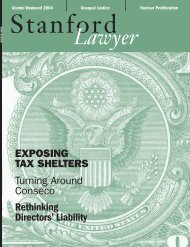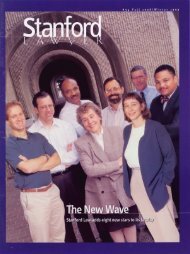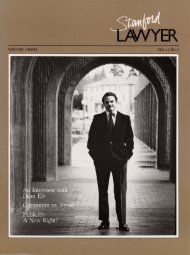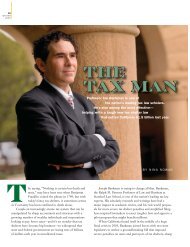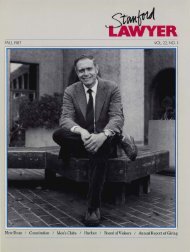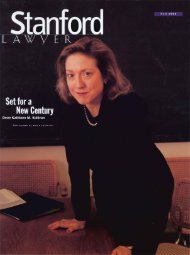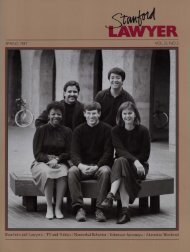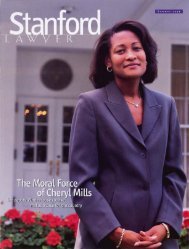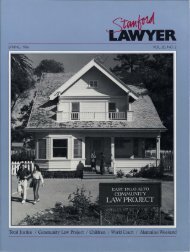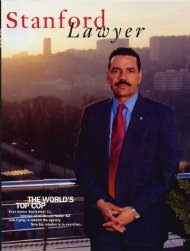Fall 1996 – Issue 50 - Stanford Lawyer - Stanford University
Fall 1996 – Issue 50 - Stanford Lawyer - Stanford University
Fall 1996 – Issue 50 - Stanford Lawyer - Stanford University
Create successful ePaper yourself
Turn your PDF publications into a flip-book with our unique Google optimized e-Paper software.
courts-all these have greeted Asians<br />
coming to California, and their children.<br />
And now, the universities of our<br />
state say that your Asian ethnicity<br />
will count against you in getting into<br />
college and law school.<br />
All this has been admitted by the<br />
<strong>University</strong> of California.<br />
Let us assume all the benefits stipulated<br />
by Dean Brest in his defense of<br />
affirmative action. If he were Dean at<br />
Boalt, a state school, instead of<br />
<strong>Stanford</strong>-would any of those<br />
benefits justify the wrong done to the<br />
student who applied, and was told<br />
she was number 43 on the Asian waiting<br />
list?<br />
Boalt Hall took a consent decree<br />
over incidents like that. But this was<br />
14 years after Bakke! Didn't the admissions<br />
committee at Boalt know<br />
that Bakke forbade a separate waiting<br />
list based on race, restricting the<br />
use of race to only a "plus factor"?<br />
No, they didn't; and the reason is<br />
as simple as it is painful. There is no<br />
logical distinction between taking<br />
someone's race into account as a<br />
"plus factor" and taking someone's<br />
race into account as the determinative<br />
factor. At the margin, the "plus" factor<br />
becomes the determinative factor-two<br />
candidates otherwise<br />
equally qualified will be distinguished<br />
for admission purposes on the basis<br />
of their race.<br />
Indeed, in the Bakke case itself,<br />
only one of the nine justices embraced<br />
this distinction between using race a<br />
little bit and using race as the deciding<br />
factor. Four justices thought it was<br />
perfectly permissible to use race as the<br />
deciding factor, if the state's intent<br />
was to do good. Four justices thought<br />
it was impermissible to use race because<br />
the 1964 Civil Rights Act compelled<br />
the federal government and the<br />
states that received federal assistance<br />
to be color-blind. Only one, Justice<br />
Lewis Powell, held that race could be<br />
used a little bit. All the other justices<br />
dismissed such a distinction.<br />
ENDS AND MEANS<br />
Justice Douglas said it best in his dissent<br />
from dismissal as moot in<br />
DeFunis v. Odegaard: Whatever benign<br />
purpose a state may have in taking<br />
a person's race into account, it is<br />
not benign to the person left out because<br />
he or she lacked the favored<br />
race characteristic. It is the fact that<br />
the state distinguished by race at all<br />
that violated the Fourteenth Amendment,<br />
in Justice Douglas's viewwhether<br />
by "plus factor" or by<br />
"determinative factor."<br />
"There is no constitutional right<br />
for any race to be preferred," Justice<br />
Douglas wrote. "There is no superior<br />
person by constitutional standards. A<br />
DeFunis who is white is entitled to no<br />
advantage by reason of that fact; nor<br />
is he subject to any disability no matter<br />
what his race or color. Whatever<br />
his race, he had a constitutional right<br />
Racial preferences,<br />
no matterhow well<br />
intentioned,<br />
teach the wrong<br />
lesson<br />
to have his application considered on<br />
its individual merits in a racially neutral<br />
manner."<br />
The defender of affirmative action,<br />
therefore, must own up to what<br />
affirmative action is, and argue that<br />
the good it accomplishes is somehow<br />
worth it. Under affirmative action, as<br />
practiced in California's universities,<br />
some applicants who would be admitted<br />
if their race were different are<br />
kept out of college and law school.<br />
As a unit of state government,<br />
UC acts under the scrutiny of the<br />
Fourteenth Amendment. For an institution<br />
like <strong>Stanford</strong>, it is Title VI of<br />
the Civil Rights Act, rather than the<br />
Fourteenth Amendment, that governs<br />
permissible behavior. Four of the justices<br />
in Bakke held that that standard<br />
was the same; but we don't have to<br />
deal with that question here for the<br />
simple reason that, I suspect, no defender<br />
of affirmative action at <strong>Stanford</strong><br />
would, if convinced that <strong>Stanford</strong>'s<br />
action violated the Fourteenth<br />
Amendment, take refuge in the fact<br />
that <strong>Stanford</strong> was a private actor.<br />
The Court of Appeals in the<br />
Hopwood case got it right: for all the<br />
benefits of diversity-and I do not<br />
denigrate those benefits in the leastit's<br />
simply not good enough to justify<br />
a state's denying a citizen a benefit<br />
that that citizen would have had were<br />
her or his race different.<br />
ALTERNATIVE REMEDIES<br />
Those of us who hold this view have<br />
good company. But we also have a serious<br />
burden.<br />
The good company is found in<br />
Justice Douglas, whose dissent from<br />
the dismissal in DeFunis was noted<br />
above; Justice Stewart, Justice<br />
Stevens, then Justice Rehnquist and<br />
Chief Justice Burger, all of whom dissented<br />
in Bakke; Justice Stanley<br />
Mosk of the California Supreme<br />
Court, who wrote the opinion for<br />
that court striking down affirmative<br />
action in California in the case the<br />
U.S. Supreme Court took in Bakke;<br />
Senator Hubert Humphrey, Senator<br />
Clifford Case, and Congressman<br />
Morris Udall, all of whom spoke passionately<br />
about the need for colorblindness<br />
in government action when<br />
the 1964 Civil Rights Act was passed;<br />
and, of course, the first Justice<br />
Harlan, magni-ficent dissenter in<br />
Plessy v. Ferguson.<br />
The heavy burden comes from<br />
this: the defenders of affirmative action<br />
(at least around <strong>Stanford</strong>) are<br />
sincerely attempting to remedy a<br />
problem that is deep and persistent<br />
and present still in our society-distinctions<br />
in outcomes based on race.<br />
Taking affirmative action out of the<br />
arsenal of weapons used to deal with<br />
that fact does not mean the fact does<br />
not exist. Indeed, it compels us to use<br />
the other weapons at hand more effectively.<br />
The U.S. Supreme Court's unfortunate<br />
4-1-4 opinion in Bakke postponed<br />
the day when those alternative<br />
remedies would be meaningfully pursued.<br />
Once it became legal to use race<br />
in admissions, promotions, etc., that<br />
was the easy course for a school (or<br />
an employer) to follow to "get their<br />
numbers right." Far preferable alternatives,<br />
which would have focused<br />
not on race but on barriers to opportunity,<br />
were not tried. Now it's time<br />
to try them.<br />
Continued on page 30<br />
FALL <strong>1996</strong> STANFORD LAWYER 5





